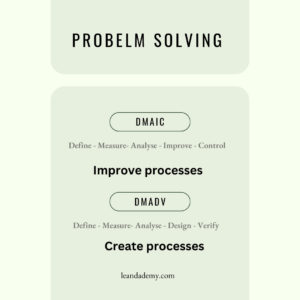
Solve problems with DMAIC and DMADV
The DMAIC methodology is a powerful tool for driving process improvements and ensuring quality management, while DMADV is used to design new processes and products that meet customer expectations. Whether you’re in manufacturing, healthcare, or any other industry, you can solve problems with DMAIC and DMADV. Each roadmap can help you systematically solve problems and enhance performance. In this blog post, we’ll walk you through each phase of DMAIC and DMADV and provide practical tips for implementing it in your organization.
What is DMAIC?
DMAIC stands for Define, Measure, Analyze, Improve, and Control. It’s a data-driven, structured approach used to improve processes. Here’s a brief overview of each phase:
- Define: Define the problem; Clearly define the problem, set objectives, and outline the project scope.
- Measure: Measure the problem; Collect relevant data, establish baselines, and measure current performance.
- Analyze: Analyze the problem; Use data analysis tools to identify the root causes of the problem.
- Improve: Improve the problem; Develop and implement solutions to address the root causes.
- Control: Monitor the improvements to ensure they are sustained over time.
Step-by-Step Guide to Using DMAIC
Define
Start by identifying the problem you want to solve. Set clear, measurable goals and outline the scope of your project. This phase is crucial for setting the foundation for the rest of the DMAIC process.
Measure
In the Measure phase, you’ll collect data to understand the current state of the process. Establish baselines and measure key performance indicators (KPIs) to quantify the problem.
Analyze
Analyze the data you’ve collected to identify the root causes of the problem. Use tools like cause-and-effect diagrams, Pareto charts, and statistical analysis to pinpoint the underlying issues.
Improve
Develop and implement solutions to address the root causes identified in the Analyze phase. Test your solutions on a small scale first, then roll them out more broadly once you’re confident they work.
Control
Finally, in the Control phase, you’ll monitor the improvements to ensure they are sustained over time. To maintain the gains, implement control plans, standard operating procedures (SOPs), and regular audits.
What is DMADV
DMADV stands for Define, Measure, Analyze, Design, and Verify. It’s a structured approach used to design new processes or products. Here’s a brief overview of each phase:
- Define: Identify the project goals and customer requirements.
- Measure: Collect data on customer needs and specifications.
- Analyze: Develop design alternatives and select the best option.
- Design: Create detailed designs and prototypes.
- Verify: Test the designs to ensure they meet customer requirements.
Step-by-Step Guide to Using DMADV
Define
Start by identifying your project’s goals and understanding the customer’s requirements. This phase is crucial for setting the foundation for the rest of the DMADV process. Could you clearly define what you want to achieve and what the customer expects?
Measure
In the Measure phase, you’ll collect data on customer needs and specifications. This involves gathering information through surveys, interviews, and market research. Establishing clear metrics and benchmarks will help you understand what the final product or process should achieve.
Analyze
Analyze the data you’ve collected to develop design alternatives. Use tools like Quality Function Deployment (QFD) and Failure Modes and Effects Analysis (FMEA) to evaluate different options and select the best one. This phase is about exploring various possibilities and narrowing down to the most feasible and practical design.
Design
In the Design phase, you’ll create detailed designs and prototypes based on the selected alternative. This involves developing detailed plans, drawings, and models. Could you collaborate with cross-functional teams to make sure the design meets all technical and customer requirements?
Verify
Finally, in the Verify phase, you’ll test the designs to ensure they meet customer requirements. This involves conducting pilot tests, simulations, and validation studies. Gather feedback from stakeholders and make any necessary adjustments to ensure the final product or process is ready for implementation.
Benefits of Using DMAIC and DMADV
Using DMADV can lead to significant improvements in product quality, customer satisfaction, and overall performance. It’s a versatile methodology that can be applied in various industries, from manufacturing to healthcare. For example, a tech company might use DMADV to design a new software application, while a healthcare provider might use it to develop a new patient care process.
Common Challenges and How to Overcome Them
Implementing DMAIC and DMADV can be challenging, especially if you’re new to the methodology. Common obstacles include resistance to change, lack of data, and insufficient resources. To overcome these challenges, it’s essential to get buy-in from stakeholders, invest in training, and ensure you have the necessary tools and resources.
If you’re interested in learning more about how Lean Six Sigma can transform your operations, or if you are ready to level up your career, check out our training page. We offer comprehensive courses that can help you master and apply these robust methodologies. Check out our Training classes.
If you want more information, please fill out our Contact Form.
Follow us on YouTube.
Follow us on LinkedIn.
